If there’s one sentence that could be applied to the development of PR from year to year, then it’s definitely this one:
The only constant is change.
Sounds like a cliche, right? But there wasn’t a time when this was more true, and not only in PR.
💡 Read Digital PR Explained: Best Strategies and Tools
A lot has happened in the first half of 2023.
Artificial intelligence (AI) went big with ChatGPT. So much that it entered almost all spheres of life, including PR. Measurement, reporting, content creation, and predictive analysis have all experienced a colossal change. But some areas still remained the same.
To investigate how the PR world has evolved and what the future holds for the industry, we’ve gathered 300 PR professionals from different industries and different company sizes to discuss their current struggles and their predictions for the next year.
Let’s take a look at the list of PR statistics drawn from the research and their interpretation.
General PR Statistics
About the participants
- We interviewed 300 participants through our company survey and HARO
- 37% of the participants work in PR, Media & Communication, 17% in Technology, 9% in Nonprofits, 7% in Government jobs, and 6% in Education
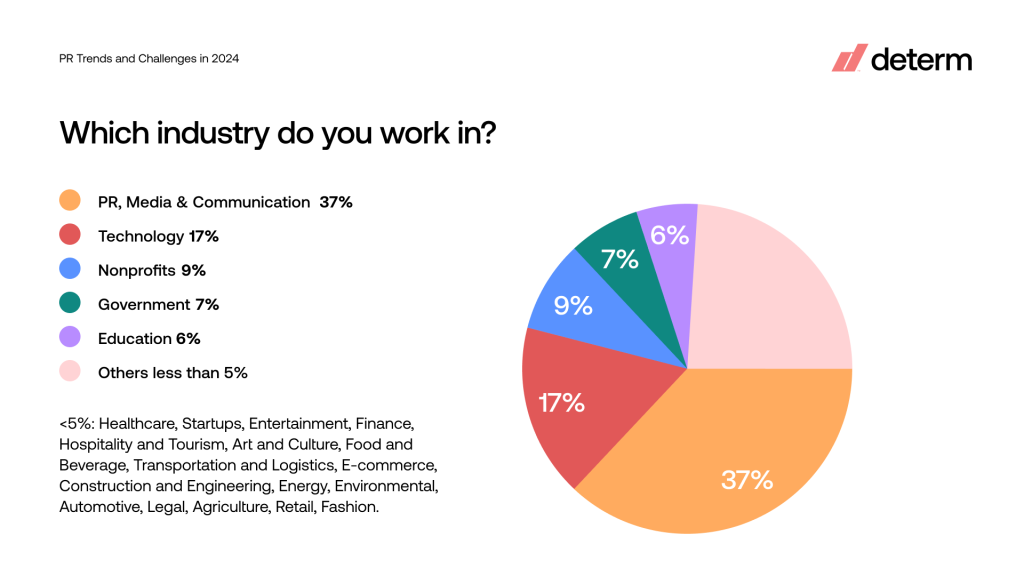
- Other industries with fewer than 5% participants include Healthcare, Startups, Entertainment, Finance, Hospitality and Tourism, Art & Culture, Food and Beverage, Transportation and Logistics, E-commerce, Construction and Engineering, Energy, Environmental, Automotive, Legal, Agriculture, Retail, Fashion
- When it comes to the size of the participants’ organizations, the majority (32%) of them work in large-sized organizations, 24% in small-sized, 22% in medium-sized and 22% in micro-sized businesses.
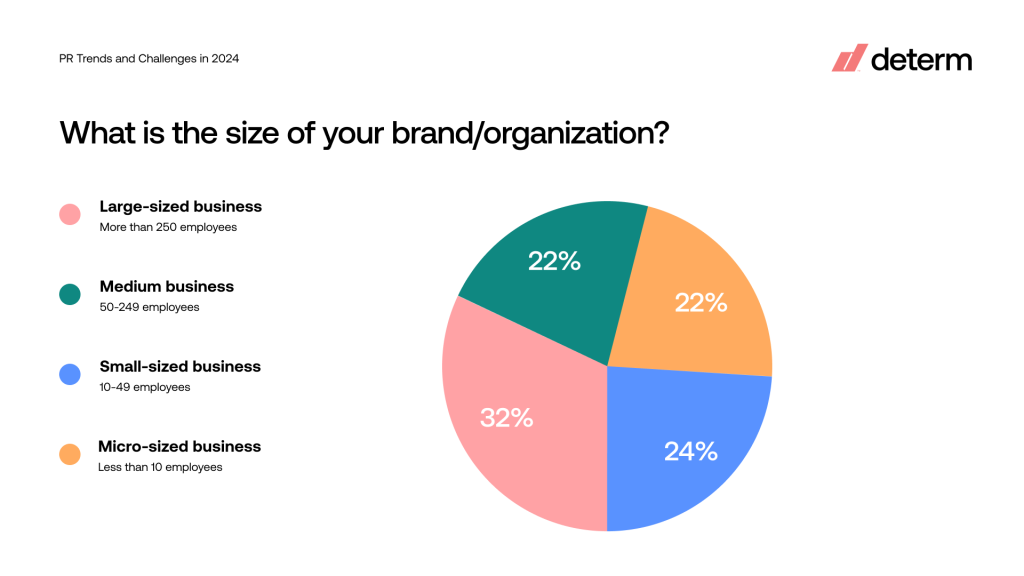
How do you prove the value of your work to your C-suite or clients?
These PR statistics show that PR professionals adopt a multifaceted approach to proving the value of their work. They combine traditional metrics like media coverage with digital metrics, website analytics, and qualitative measures such as sentiment analysis and customer feedback. The inclusion of financial metrics demonstrates an understanding of the need to align PR efforts with broader business goals.
- 79% of PR professionals prioritize proving value through media coverage and reach; this emphasizes the impact of securing placements and reaching a wide audience.
- 56% emphasize social media metrics, indicating the growing importance of digital platforms in assessing PR effectiveness.
- 50% focus on website traffic and analytics, highlighting the connection between PR activities and online engagement.
- 41% utilize case studies and success stories strategically to illustrate tangible outcomes and positive results.
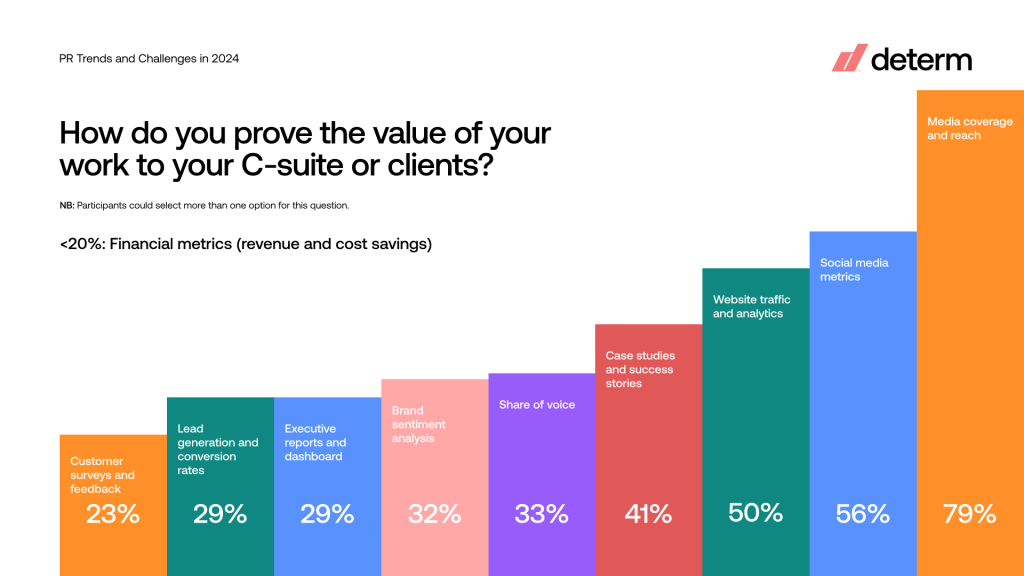
- 33% consider the share of voice, emphasizing the importance of understanding a brand’s presence relative to competitors.
- 32% include brand sentiment analysis, recognizing the significance of measuring emotional tone and perception.
- 29% use executive reports and dashboards for concise, visually appealing summaries for decision-makers.
- 29% demonstrate impact on lead generation and conversion rates, aligning PR efforts with business objectives.
- 23% utilize customer surveys and feedback for qualitative insights into the perceived value of PR efforts.
- 18% focus on financial metrics (revenue and cost savings), linking PR efforts directly to bottom-line impact.
What is the most time-consuming task in your role?
The PR statistics reflect a heavy emphasis on hands-on tasks like content creation and media relations, indicating the labor-intensive nature of these aspects in the PR role. While monitoring and analysis are recognized as time-consuming, they are not perceived as the primary time drivers, highlighting the operational and relationship-building aspects as central to PR professionals’ workload.
- 62% of PR professionals identify content creation (pitches, press releases) as the most time-consuming task, emphasizing the effort invested in crafting effective communication materials.
- 57% acknowledge media relations (finding journalists, nurturing relationships) as a substantial time commitment, underscoring the importance of building and maintaining connections with the media.
- 36% note monitoring and analysis (interpreting data) as time-consuming, indicating the significance of analytical aspects in PR work, though not the primary time driver.
- 29% recognize internal communications as a time-consuming responsibility, emphasizing the importance of clear communication within the organization.
- 13% consider press clipping as the least time-consuming task, suggesting that, with digital tools, organizing media coverage may be perceived as less time-intensive compared to other responsibilities.
Read Productivity in PR: Benefits, Tips, Best Tools & Books
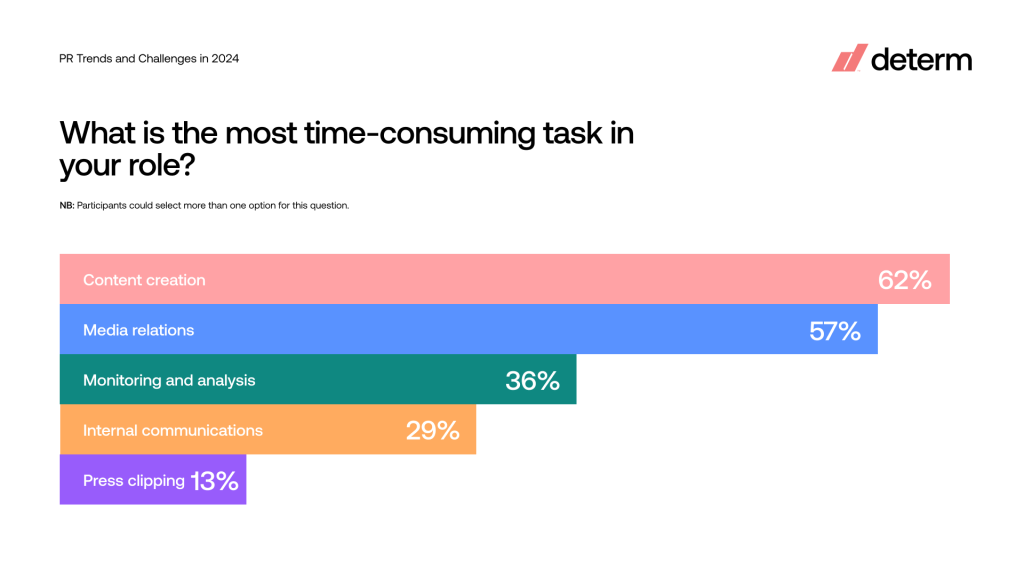
If we consider the size of the business…
- Small businesses find content creation to be the most time-consuming. This likely indicates that with limited personnel or resources, the creation of compelling and engaging content for various platforms demands significant effort.
- Micro-sized businesses highlight media relations as the most time-consuming task. This suggests that, despite their small scale, these businesses recognize the importance of building and maintaining relationships with journalists and media outlets.
- Medium-sized businesses, similar to small-sized businesses, also cite content creation as a major time-consuming task. This implies a recognition of the ongoing need to generate relevant and impactful content to sustain communication efforts.
- Large businesses point to media relations as the most time-consuming task. With potentially larger and more complex communication needs, these businesses may invest significant time in managing relationships with a wide array of media outlets
Read How to Use Media Monitoring to Boost Your Communication Strategy
“We spent so much time using Google trying to find where we were mentioned online. It was one of the most consuming tasks for us but we soon realized that that was a big waste of time, because media monitoring tools exist.” Ivona Mrvoš, Marketing Manager at Include
PR Statistics: Public Relations Now
In the next part, we’ve tried to dig deeper in the situation in PR at the moment. What are the main data collection methods, which metrics and PR tactics are prioritized, which challenges do PR professionals face in general and when it comes to media monitoring, and how they analyze media mentions.
Which PR tactics do you use to earn coverage?
- 87% PR professionals overwhelmingly rely on press releases for media coverage.
- 70% consider social media campaigns the most effective PR tactic.
- 55% use media events and press conferences in their strategies.
- 52% employ media pitches for targeted outreach.
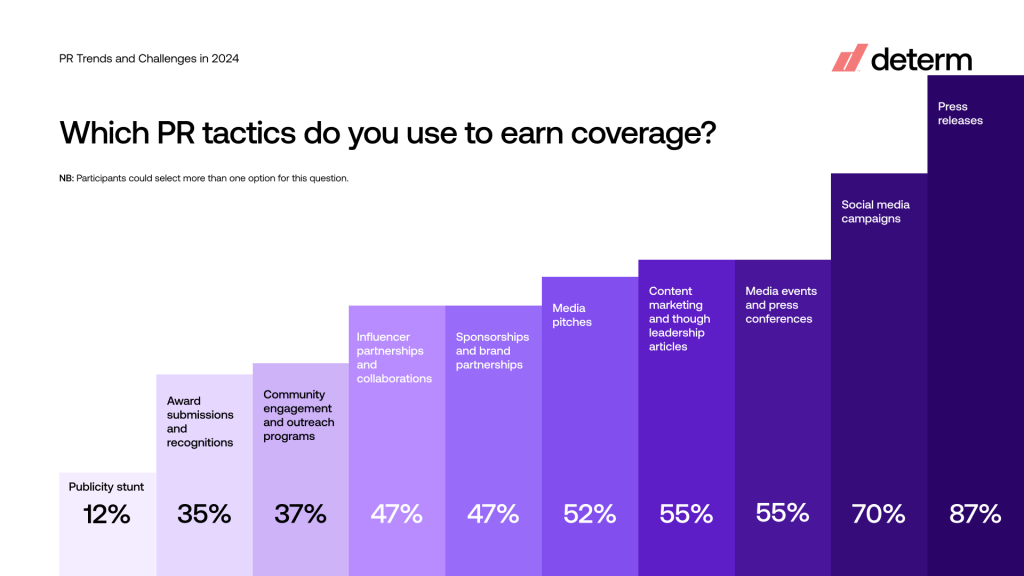
- 47% utilize sponsorships, brand partnerships, and influencer collaborations equally.
- 37% engage in community outreach programs for coverage.
- 35% leverage award submissions and recognitions in their PR efforts.
- 12% use publicity stunts, indicating a less common approach.
In summary, these PR statistics illustrate a diverse PR landscape where professionals employ a mix of traditional and digital tactics. Press releases, social media campaigns, and face-to-face interactions through events and press conferences remain prominent, while partnerships, community engagement, and awards also play significant roles in earning media coverage.
Publicity stunts, however, are less commonly used, possibly due to the inherent challenges and potential drawbacks associated with such unconventional approaches.
Read Revolutionizing PR: How AI-powered Media Monitoring Can Benefit PR Professionals
“The personal touch in PR will reign supreme. The era of generic press releases is waning. Now a time has come for personalized storytelling, where content is tailored to the nuances of each segment.”
Milosz Krasinski, Managing Director at Chilli Fruit Web Consulting
Which challenges is your team currently facing?
- 66% of PR professionals state budget limitations as the primary challenge, impacting the execution of comprehensive strategies and initiatives.
- 41% of PR teams struggle with measuring results and reporting ROI, indicating a need for more effective metrics and reporting mechanisms.
- 39% face challenges in getting responses from journalists, possibly due to increased competition or difficulties in effective story pitching.
- About one-third (33%) encounter challenges in discovering relevant journalists, highlighting the difficulty in targeting the right media contacts.
- Another 33% express challenges with the lack of quantifiable measurement, emphasizing the need for concrete metrics to assess PR impact.
Read PR Metrics: 6 Ways To Measure Your Brand’s Success
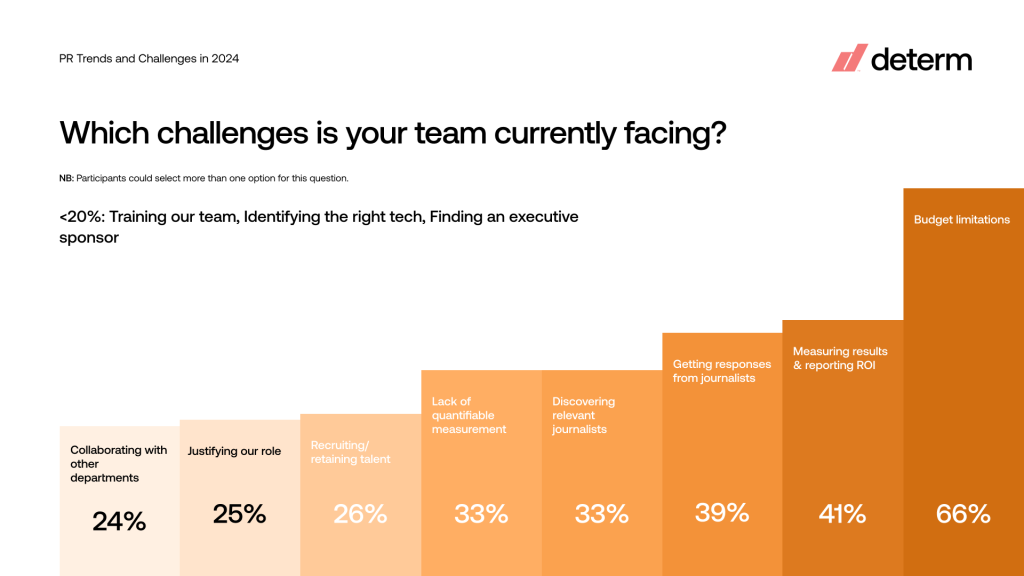
- 26% of PR professionals face challenges in recruiting and retaining talent, indicating potential competitiveness and turnover issues.
- 25% struggle with justifying the role of PR within their organizations, emphasizing the need for clear communication of PR value.
- 24% encounter challenges in collaborating with other departments, pointing to potential communication and integration issues.
- 20% express challenges in training their teams, indicating a need for ongoing professional development.
- 17% face challenges in identifying the right technology, suggesting difficulties in choosing and implementing suitable tools.
- 11% of PR professionals struggle with finding an executive sponsor, indicating potential challenges in securing high-level support for PR initiatives.
- A smaller subset (9%) faces challenges in collaborating within their teams, potentially indicating communication or workflow issues.
Read (TEMPLATE) A Guide to Creating an Annual Communications Plan
PR professionals face challenges in measuring results and reporting return on investment (ROI), emphasizing the necessity for improved metrics. These PR statistics underscore a careful balance between financial limitations and the need for tangible returns on PR investments, necessitating strategic finesse for optimal outcomes.
“Independent remote PR Consultants will be the silent partners small businesses need to earn media coverage that matters, for a fraction of the advertising costs associated with top media coverage. Proving that PR is in fact a necessary evil in business growth – not a luxury service only available to large companies with budgets.”
Gabrielle Pickens, Independent PR consultant at Pickens Creative
Which of these data collection methods has your organization used in the past 12 months?
- 47% of PR professionals report using surveys as a data collection method in the past year, emphasizing the prevalence of this approach for gathering insights.
- A similar percentage, 46%, indicates the use of social listening, highlighting the significance of monitoring social media conversations to understand public sentiment
- About 36% have employed interviews as a data collection method, showcasing the continued relevance of qualitative approaches for in-depth exploration.
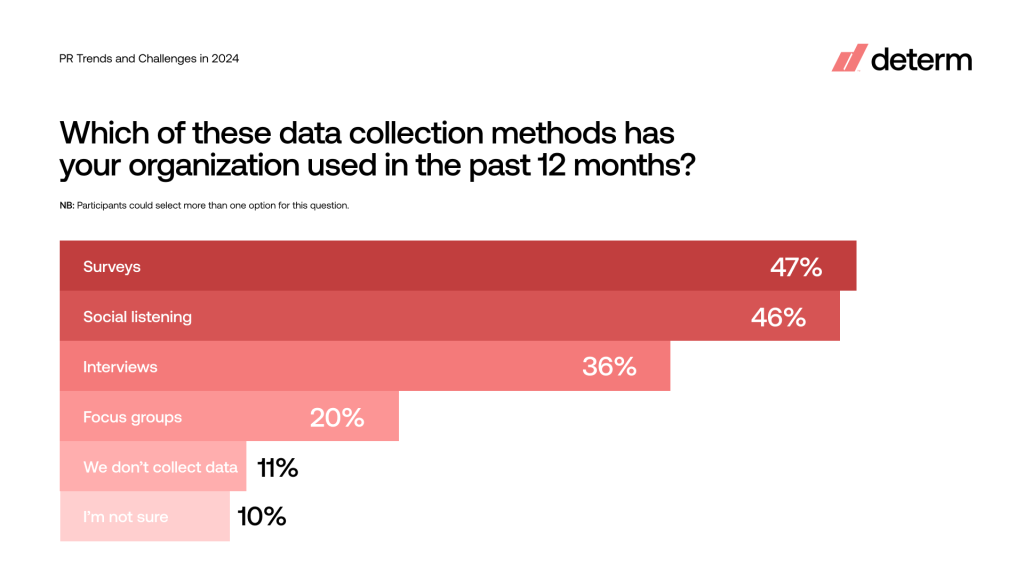
- One-fifth of organizations (20%) have utilized focus groups, demonstrating a modest use of group discussions for feedback on specific topics.
- 11% state that their organizations don’t collect data, indicating a segment with either a limited emphasis on data-driven insights or potential gaps in data collection practices.
- 10% report that their organizations have not used any of the specified data collection methods in the past 12 months, reflecting variability in data practices within the PR landscape.
The PR statistics suggest a diverse use of data collection methods, with surveys and social listening being the most prevalent. The presence of organizations not collecting data or being unsure about their methods underscores the variability in data practices within the PR landscape. Implementing a mix of quantitative and qualitative approaches appears common for gaining valuable insights.
Read How to Do Market Research With a Media Monitoring Tool
If we consider the size of the business…
- Small and micro-sized businesses, likely more resource-constrained, turn to social listening as a primary method. Social media platforms provide accessible data, allowing smaller businesses to understand audience sentiment, preferences, and trends without the need for extensive survey infrastructure.
- Medium and large-sized businesses, with potentially more resources at their disposal, opt for surveys. Surveys offer a structured and customizable approach to gathering specific information directly from their target audience. This method allows for in-depth insights and can be tailored to address specific research objectives.
“We use social listening for planning what we should do. But we can also see our campaign’s impact. For example, when we launch a new model and see how people react and gather all information that we need.” Resa Prasetyo, Regional data and analytics director at TBWA
How do you currently track and analyze media mentions of your organization or brand?
- 59% of PR professionals use media monitoring tools and social listening platforms, indicating a preference for comprehensive and automated solutions.
- 50% of the respondents utilize Google Alerts, suggesting a widespread reliance on this accessible tool for basic media mention tracking.
- 44% employ press clipping services, showing a willingness to outsource monitoring and analysis to specialized providers.
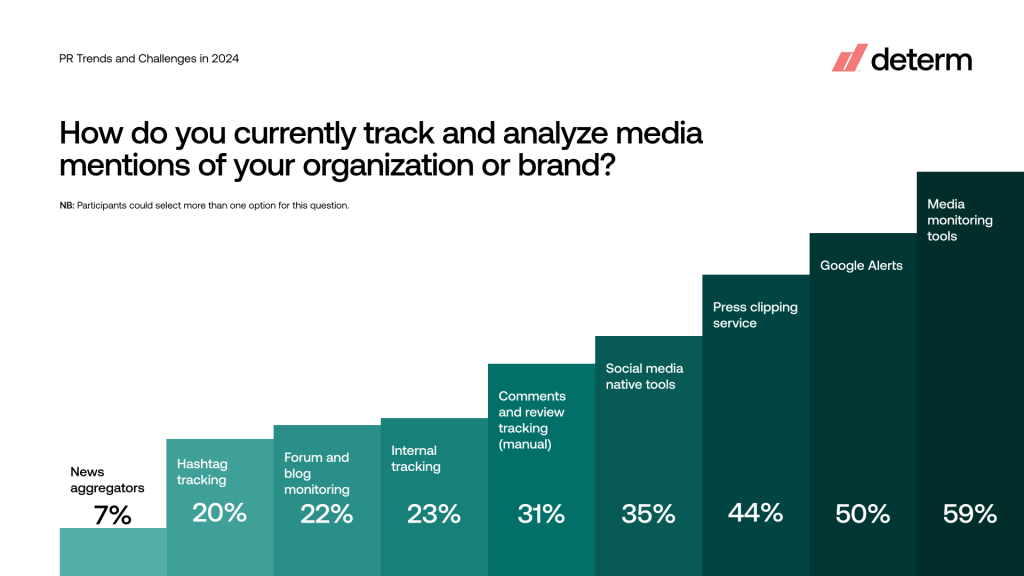
- 35% rely on native tools provided by social media platforms, emphasizing the importance of monitoring social media conversations directly.
- 31% track mentions through monitoring comments and reviews, highlighting a focus on user-generated content and public sentiment.
- 23% use internal tracking mechanisms, indicating a custom approach for monitoring media mentions specific to organizational needs.
- 22% manually monitor forums and blogs, reflecting a hands-on approach to tracking online discussions in niche communities.
- 19% use hashtag tracking, recognizing the significance of hashtags in organizing and tracking conversations on social media.
- 8%: A small percentage relies on news aggregators, indicating limited use of these tools to aggregate news from various sources.
The results demonstrate a diverse set of tools and approaches used by PR professionals for tracking and analyzing media mentions. According to these PR statistics, the majority opt for specialized tools and services, while a significant portion utilizes free or internal solutions. This diversity reflects the varied preferences and needs within the PR community for monitoring brand visibility and sentiment across different channels.
“Numerous times, something happened, and we were the last to know. Now, we are timely informed of everything. We check Determ every day, and if something important occurs, we automatically get a Spike alert and are able to react immediately.” Martina Crnčević, Marketing and Web Associate at Zadar Tourist Board
What metrics do you prioritize when evaluating media monitoring results?
- 76% of PR professionals prioritize reach, which indicates a focus on broad visibility and brand awareness in media monitoring.
- 70% emphasizes engagement, which highlights the recognition of audience interaction and participation as crucial metrics.
- 49% prioritize conversations over time, which suggests focusing on the longevity and sustained impact of media coverage.
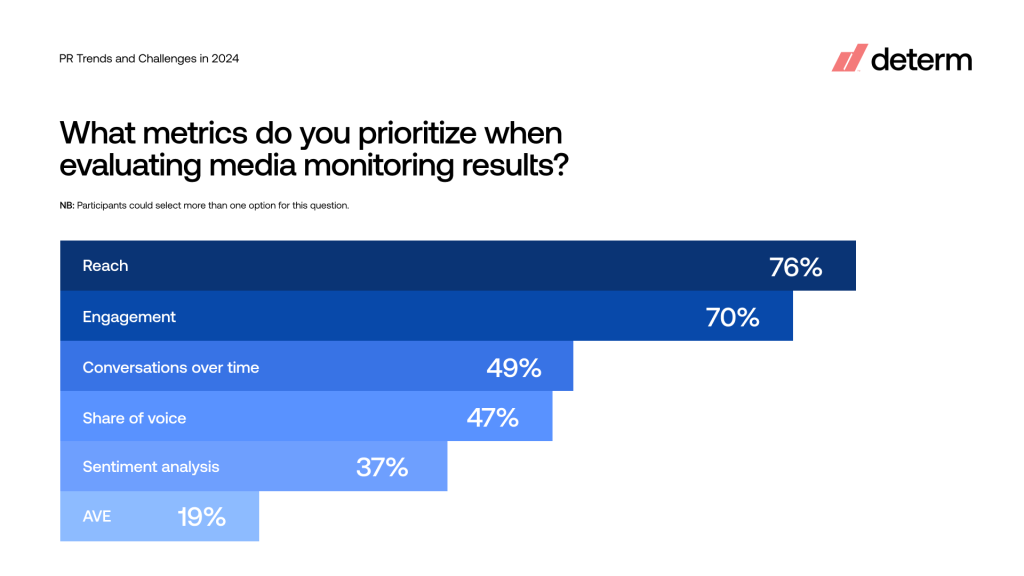
- 47% chose share of voice, which indicates a concern for a brand’s visibility relative to competitors in the overall conversation or media space.
- 37% of PR professionals included sentiment analysis, which shows an interest in understanding the emotional tone and perception surrounding media coverage.
- 19% prioritize AVE, which suggests that many PR professionals do not view monetary valuation as a primary metric, emphasizing a shift towards more comprehensive measurement approaches.
The results reveal a dual emphasis on both quantitative metrics like reach and engagement, as well as qualitative metrics such as sentiment analysis. Long-term impact and competitive positioning are also considerations, while the use of AVE is less prevalent, possibly reflecting a shift towards more comprehensive and nuanced measurement approaches.
Read 3 Common PR Metrics You Are Probably Using Wrong
If we consider the size of the business…
- Small businesses prioritizing engagement over reach may indicate a focus on building meaningful connections with a narrower audience. These PR statistics show that they might value interactions, comments, and relationship-building as key indicators of success, potentially reflecting a strategy centered on community engagement and customer loyalty.
- Medium and large businesses prioritizing reach over engagement may suggest a broader, brand-awareness-oriented strategy. These businesses could be more focused on maximizing the visibility of their messaging across a wide audience, aiming to increase brand recognition and capture a larger market share
“My favorite thing is at the end of the year when I summarize what Marketing has done in the past year. The number of mentions in the millions that I could not prove otherwise. And when I compare it to the competition, no one can tell me we didn’t do a good job.” Tatjana Paunoski, Head of PR and Marketing at Bingo d.o.o
What challenges do you face with media monitoring in 2023?
- 65% of PR professionals grapple with challenges related to noise and irrelevant data, indicating a struggle to filter and focus on the most relevant information.
- 40% face challenges with false positives and incorrect sentiment analysis, highlighting concerns about the accuracy of automated tools in interpreting media mentions
- More than one-third (38%) find real-time monitoring challenging, suggesting a demand for more immediate insights into media mentions.
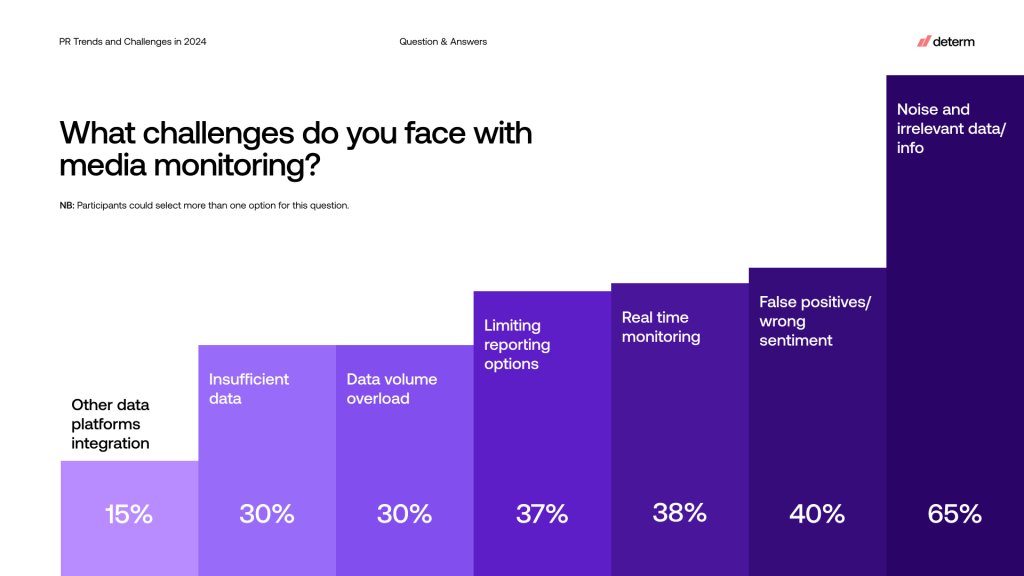
- 37% encounter challenges with limiting reporting options, possibly indicating constraints in customizing reports to specific needs.
- 31% of PR professionals struggle with data volume overload, emphasizing the difficulty of managing and analyzing a large amount of data.
- 30% face challenges related to insufficient data, pointing to gaps in coverage or a lack of comprehensive information.
- 15% encounter challenges with integrating data from other platforms, indicating difficulties in consolidating information for a unified view.
The challenges in media monitoring for PR professionals in 2023 revolve around issues of information quality, accuracy and timeliness. Additionally, the PR statistics show challenges to manage and make sense of large volumes of data. All of these highlight the need for advanced and adaptable media monitoring tools to address the demands of the PR landscape.
“Sometimes I do Google searches on press coverage, and the story I’ve seen in Determ hasn’t appeared on my Google feed. So it would take hours. (…) But you know, I spend no more than two or three hours a month now, including the data cleansing, to generate reports that would otherwise take me… What days? Just days.” Natalie Homer, Director of Public Relations at HiBob
PR Statistics: Predictions For 2024
The final part was aimed at finding out what PR professionals expect from the next year. This includes the skills they’ll need, AI, budgeting, etc.
What new skills and competencies do you think PR & Marketing professionals will need to thrive in 2024?
- The majority (76%) of PR professionals emphasize the need for skills in AI and technology integration. This reflects the industry’s focus on leveraging technology for enhanced strategies.
- 70% underscore the importance of skills in data analytics and interpretation. This proves a demand for professionals adept at deriving insights from data.
- More than half (55%) of PR professionals highlight the necessity of skills in crisis management and communication, emphasizing the importance of navigating challenges effectively.
- 52% emphasize the significance of skills in visual content creation, reflecting the demand for professionals who can produce engaging visual content.
- A significant 50% underscores the importance of skills in social media strategy and management, reflecting the ongoing relevance of effective social media practices.
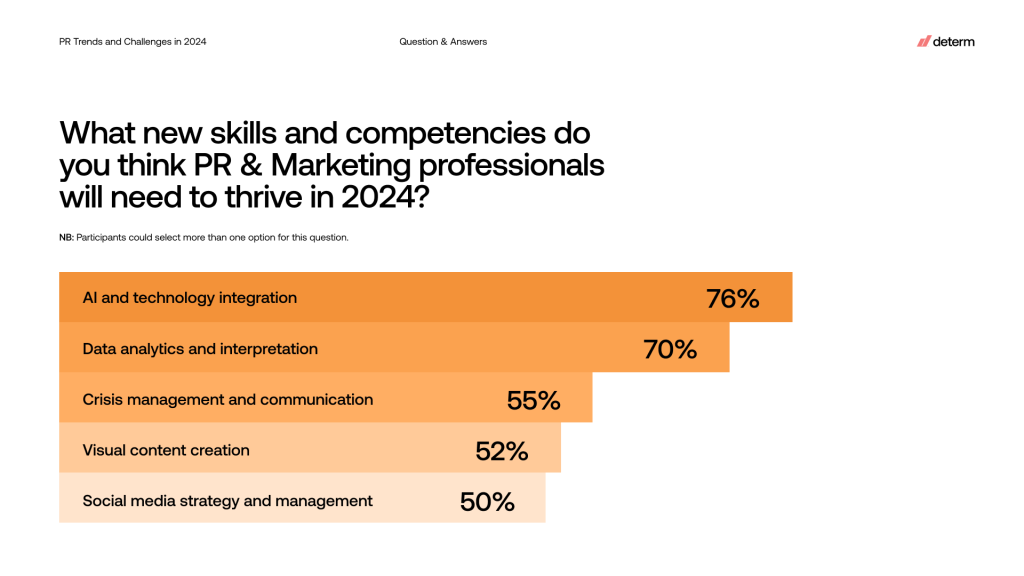
Read How PR Professionals Can Use Media Monitoring And Stay Ahead of the Game
Professionals in PR and Marketing are anticipated to thrive in 2024 by acquiring skills in AI and technology integration, data analytics and interpretation, crisis management and communication, visual content creation, and social media strategy and management. This reflects the evolving landscape of the industry, where technological advancements, data-driven decision-making, and effective communication strategies play pivotal roles in success.
“AI tools will not only streamline the process of media monitoring and analytics but also allow for hyper-personalization in PR campaigns, enabling companies to engage with stakeholders in a more meaningful way.”
Markus Kraus, Head of Sales and Marketing at Trading Verstehen
Which areas of work do you think AI assists Public Relations (PR) professionals the most?
- The majority of respondents (82%) view AI as most beneficial in content creation and writing assistance, indicating its significant role in improving efficiency and quality.
- More than half (58%) recognize AI’s value in media monitoring and analysis, suggesting its contribution to efficiently tracking and analyzing media coverage.
- Nearly half (48%) acknowledge AI’s role in data analytics and performance measurement, indicating its assistance in interpreting data for assessing PR strategies.
- 44% of PR professionals see AI as valuable in automated reporting and data visualization, highlighting its contribution to streamlining reporting processes.
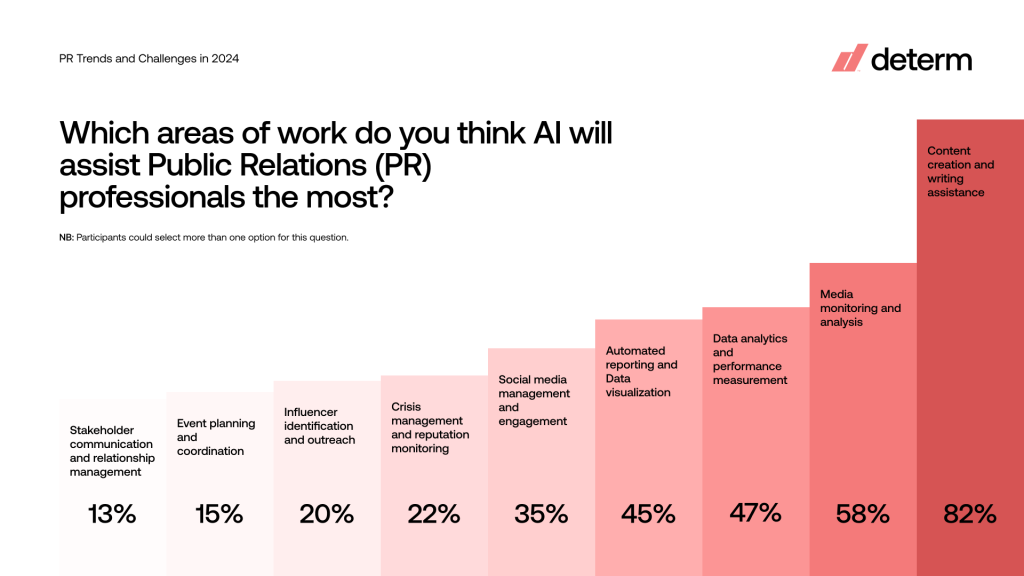
- Over one-third (35%) believe AI supports social media management and engagement. This shows its important role in automating tasks and optimizing engagement strategies.
- 22% acknowledge AI’s role in crisis management and reputation monitoring, suggesting its assistance in identifying and addressing potential crises.
- 20% recognize AI’s role in influencer identification and outreach, indicating its support in streamlining influencer-related efforts.
- 15% see AI contributing to event planning and coordination, implying its potential role in organizing and managing PR events.
- A smaller percentage (13%) believes AI supports stakeholder communication and relationship management, suggesting its facilitation of communication strategies with various stakeholders.
PR professionals see AI as highly valuable in content creation and writing assistance, with substantial recognition in areas such as media monitoring, data analytics, and reporting automation. While AI’s influence in social media management and crisis management is acknowledged, it’s perceived as less prominent in event planning and stakeholder communication. These perceptions highlight the multifaceted contributions of AI across various aspects of the PR profession.
“AI’s role in PR will transcend mere analytics, it will craft narratives that resonate on a personal level, leveraging data to understand and predict audience behaviours and preferences.”
Milosz Krasinski, Managing Director at Chilli Fruit Web Consulting
In 2024, which channels do you plan to allocate your PR and marketing efforts to?
- The highest percentage of PR professionals, 70%, prioritizes LinkedIn, emphasizing its central role in professional networking and B2B marketing.
- For almost equally high, 69%, the focus is on Instagram, highlighting its popularity for visual content and engagement.
- 67% of participants plan to allocate efforts to news media outlets, underscoring the continued importance of traditional media coverage.
- About 55% of them direct efforts to Facebook, indicating its sustained role as a key platform for PR and marketing activities.
- 52% target specialized websites, recognizing their significance for targeted outreach.
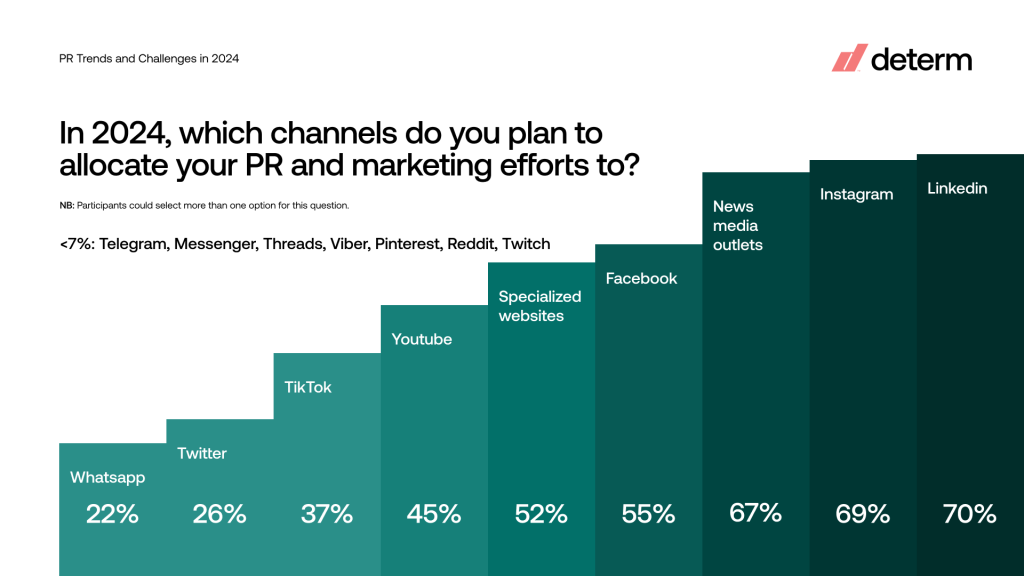
- 45% plan to allocate efforts to YouTube, emphasizing the continued importance of video content.
- A notable 37% of PR professionals focus on TikTok, acknowledging its growing influence for short-form video content.
- 26% of them allocate efforts to Twitter, indicating its role in real-time updates and engagement.
- 22% of PR professionals include WhatsApp in their plans, recognizing its role in direct and personalized communication.
- Another 6% includes Telegram, reflecting a focus on this platform for secure and private communication. The same percentage allocates efforts to Messenger, indicating a focus on direct messaging platforms.
- Below 5% of participants will direct efforts to Threads, Viber, Pinterest, Reddit, and Twitch
There is a diverse landscape of channel preferences for PR efforts, with a collective acknowledgement of the value of leveraging various platforms to achieve strategic goals. However, Linkedin stands out, indicating a collective emphasis on professional networking and B2B marketing. It is followed closely by Instagram, reinforcing its role as a primary channel for visual content and audience engagement. The efforts allocated to news media outlets highlight the continued importance of traditional media coverage.
If we consider the size of the business…
- Smaller businesses, likely with limited resources, prioritize Instagram. This choice suggests a focus on visually engaging content, influencer collaborations, and direct engagement with a broad online audience. Instagram provides a platform for these businesses to connect with their target demographic through visual storytelling.
- Medium and large-sized businesses, with potentially larger budgets and a broader audience scope, prioritize news media outlets. This indicates a strategic focus on traditional media channels to reach a wider audience and build brand credibility. Ultimately it secures coverage that aligns with their broader business goals.
“The media landscape will continue to evolve, with an increasing focus on niche and alternative media channels. PR professionals need to diversify their media outreach strategies, including collaborations with influencers, podcasts, and emerging digital platforms. Building relationships with non-traditional media outlets will be crucial for comprehensive coverage.”
Stephen Gagnon, SEO and website designer at Calgary/Airdrie
Which tools does your team use or plan to use in 2024?
- The majority of PR teams (62%) plan to use media monitoring tools in 2024, highlighting the continued importance of real-time tracking for effective PR strategies.
- An equal percentage (62%) intend to use Editorial/Content/Marketing Calendars. The emphasis remains on organized content planning and coordination within teams.
- Nearly half of the teams (48%) plan to incorporate reporting and data visualization tools, recognizing the importance of visually appealing reporting for conveying PR performance metrics effectively.
- A substantial percentage, 45.53%, aims to use content editing tools. There is a continued emphasis on crafting high-quality and engaging content as a key aspect of PR strategies.
- 43% of teams plan to integrate SEO tools, emphasizing the importance of incorporating search engine optimization practices into PR efforts for enhanced online visibility.
- 33% of teams express a plan to use email marketing software. This suggests a growing recognition of the role of email campaigns in PR strategies.
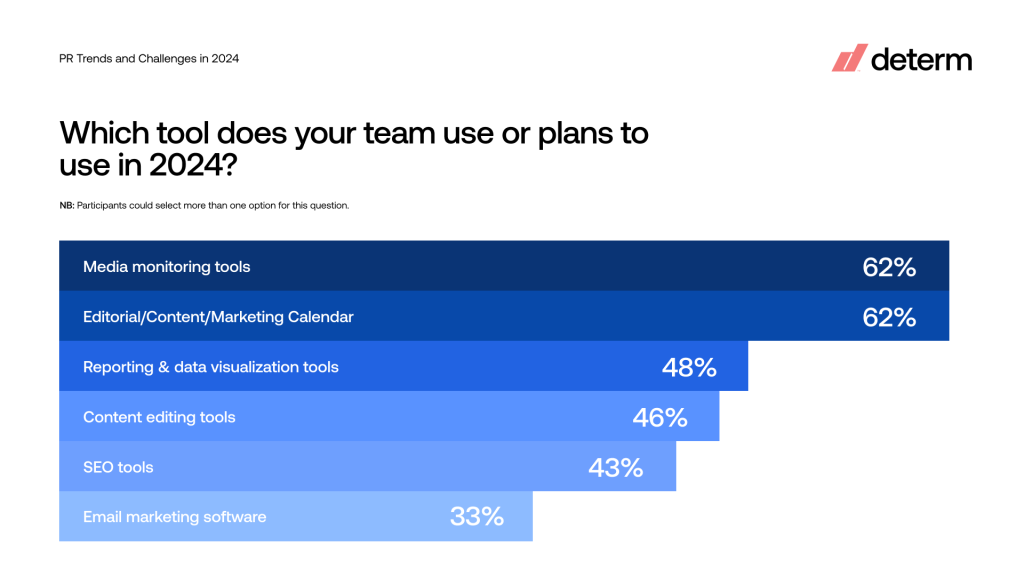
The data suggests a strong focus on media monitoring, content planning, and data visualization tools for PR teams in 2024. The combination of these tools reflects a holistic approach to PR strategies. This kind of approach incorporates real-time monitoring, organized content creation, effective reporting, and optimization for online visibility.
If we consider the size of the business…
- Smaller and medium-sized businesses prioritize the use of editorial/content/marketing calendars. This suggests a focus on organized content planning, scheduling, and strategic coordination of marketing efforts. These businesses likely see the value in planning and executing content across various channels to maintain a consistent and cohesive brand presence.
- Medium and large-sized businesses prioritize media monitoring tools. This indicates a strategic focus on tracking and analyzing media mentions, sentiment, and industry trends. Larger businesses often have more extensive media coverage and a greater need to monitor their brand reputation across various channels.
“PR professionals must craft stories that resonate on a personal level, and that are truly relevant to the audience. This means moving away from the traditional and generic press release and shifting towards a more tailored narrative that can speak to diverse audience segments.”
Gianluca Ferruggia, General Manager at Design Rush
What improvements or new features would you like to see in media monitoring tools for 2024?
- The majority (67%) of PR professionals desire predictive analytics for anticipating future trends and events
- An equal percentage (67%) emphasizes the importance of global and local trend detection. There is a strong need for tools that identify emerging trends on various scales.
- 53% seek prescriptive analysis. This demonstrates a desire for tools that not only provide insights but also offer actionable recommendations for different situations.
- Almost half (47%) of the participants desire advanced sentiment analysis with contextual understanding. There is clearly a need for nuanced sentiment interpretation in diverse contexts.
Read Future of PR: 5 Predictions for 2024
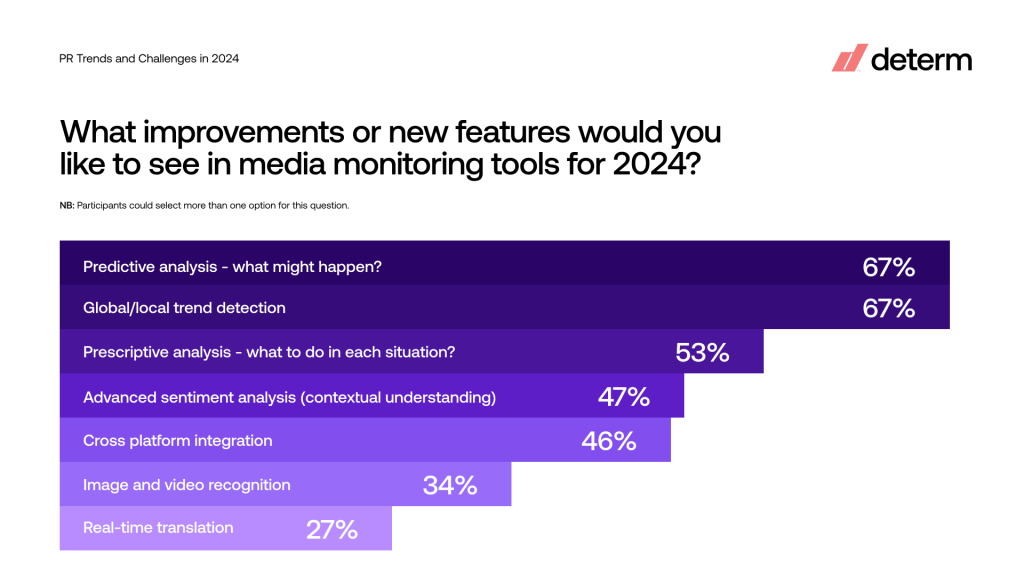
- 46% highlight the importance of cross-platform integration, indicating a desire for tools that seamlessly integrate data from various platforms.
- 34% express a desire for image and video recognition capabilities, recognizing the significance of analyzing visual content.
- 26% seek real-time translation features, reflecting a demand for tools that facilitate communication across languages in real-time.
The desired improvements in media monitoring tools for 2024 include advanced analytics capabilities for prediction, trend detection, and prescriptive analysis. Additionally, there is a notable interest in features like advanced sentiment analysis, cross-platform integration, image and video recognition, and real-time translation to enhance the comprehensiveness and effectiveness of media monitoring efforts.
“In 2024, the use of AI for predictive analytics and more personalized content will be paramount. AI can analyze large datasets to forecast media trends, enabling us to tailor our messages to audiences more effectively.”
Jim Christy, Head of Sales and Marketing at Midwest Cards
What do you think will be the main trends that will shape global PR efforts in 2024?
- The highest percentage of PR professionals, 55%, indicate that a significant trend in 2024 will be a heightened focus on ESG, emphasizing sustainability and ethical business practices.
- Almost equally high, at 54%, is the expectation for an increased focus on authenticity and transparency. Genuine connections and transparent communication in PR strategies remain one of the highest priorities.
- 51% of PR professionals predict Diversity, Equality, and Inclusion (DEI) as a prominent trend. This shows the growing importance of promoting diversity and inclusion in PR campaigns.
- About 39% of PR professionals expect a continued emphasis on Corporate Social Responsibility (CSR), underlining the enduring importance of businesses contributing positively to societal and environmental concerns.
- 35% of participants anticipate a trend toward increased Employee Advocacy, suggesting a focus on leveraging employees as brand ambassadors in PR strategies.
- A slightly smaller percentage, 30%, predicts the Rise of Influencer Marketing as a notable trend. This indicates the enduring relevance of influencers in shaping public opinion and engagement.
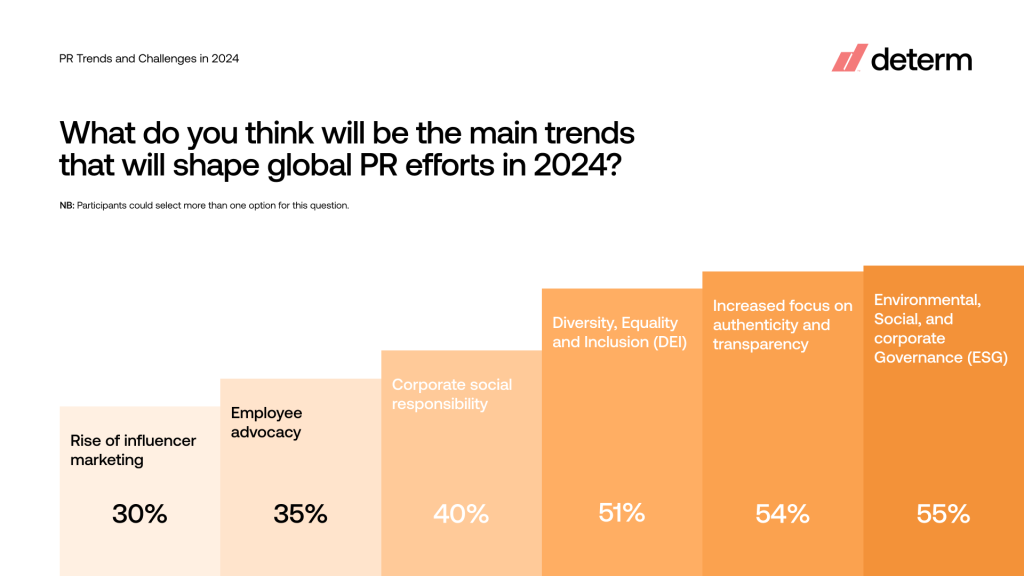
The anticipated trends in global PR efforts for 2024 include a strong emphasis on ESG practices. In addition, there is a heightened focus on authenticity and transparency and a commitment to DEI. Further on CSR will play a huge role, just like employee advocacy, and the ongoing influence of influencer marketing. These trends collectively reflect the evolving landscape of PR, incorporating ethical considerations, genuine communication, and a commitment to social responsibility.
“PR efforts will increasingly revolve around purpose-driven communication. Companies will align their messaging with social and environmental causes, reflecting the values of their audience. Purpose-driven PR fosters authenticity and builds stronger connections with stakeholders.”
Max Shak, Founder/CEO at nerDigital
Key Takeaways
- Proving PR Value – PR professionals use a multifaceted approach to prove the value of their work, with a focus on media coverage, social media metrics, website analytics, and qualitative measures.
- Time-Consuming Tasks – Content creation and media relations are identified as the most time-consuming tasks for PR professionals.
- PR Tactics for Coverage – Press releases, social media campaigns, and media events are the most commonly used tactics for earning media coverage.
- Challenges in PR – Budget limitations, measuring results, and journalist responsiveness are identified as key challenges in the PR industry.
- Data Collection Methods – Surveys and social listening are prevalent data collection methods, with variations based on the business size.
- Media Mention Tracking – PR professionals use a variety of tools to track and analyze media mentions. The focus is on media monitoring tools and Google Alerts.
- Metrics Prioritization – Metrics like reach, engagement, and conversations over time are prioritized, indicating a balance between quantitative and qualitative assessment.
- AI’s Role in PR – AI is seen as highly beneficial in content creation, media monitoring, and data analytics.
- 2024 Channel Allocation – LinkedIn, Instagram, and news media outlets are prioritized channels, with variations based on the business size.
- Tools for 2024 – Media monitoring tools, editorial/content/marketing calendars, and reporting/data visualization tools are key tools planned for use in 2024.
- Desired Improvements in Tools – PR professionals express a desire for predictive analytics, global/local trend detection, advanced sentiment analysis, and cross-platform integration in media monitoring tools for 2024.
- Anticipated Trends in 2024 – Key trends include a focus on ESG, authenticity, DEI, CSR, employee advocacy, and the continued relevance of influencer marketing.